Avoncroft Museum of Historic
Buildings
Bromsgrove, Worcestershire
Avoncroft is a 15 acre open-air industrial and
architectural museum. It opened in 1967 and came about as a result of needing a
new home for a 15th century timber framed building, the Merchants House, that
was being dismantled nearby. It is now home to 25 of historic buildings covering
seven centuries, which includes a:
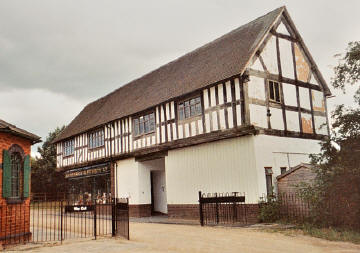
 Behind here is the Telephone Kiosk
Exhibition
Behind here is the Telephone Kiosk
Exhibition |
- String of Horses
Inn from Shrewsbury
- 19th
century buildings include the Toll Keeper’s House from Little Malvern, a
‘tin chapel’ from Herefordshire and a Victorian cell block
- 20th
century exhibits include an Edwardian living wagon made for a travelling
showman and a 1940's Prefab showing how people lived after being re-housed
following the Second World War.
Representing rural life there are a
representation of farm buildings including a:
- working 19th Century Windmill
- Crushing mill for making Worcestershire
cider and perry
- 17th century cock pit
- 16th Century cruck barn from Cholestrey
in Warwickshire
|
All the buildings are made of all types of
materials from timber, brick, corrugated iron, steel, asbestos, concrete and
fibreglass.
As well as it's buildings it is also home to
The National Telephone Kiosk Collection which explores the development of the
telephone kiosk both in terms of social and material history. There are many
displays covering this history including:
- A 1950's standard building which
houses a Unit Automatic Exchange, the building was originally a
working exchange. These buildings came in different sizes and materials
chosen to fit the location and budget of the time, the one on display here
is made of wood. The Exchange Units also came in different sizes according
the number of telephone users to be served, this example housed in this
wooden building is a UAX-13 which could service a maximum of 800
connections.
- Police Call Pillars or Emergency
Pillars and Police Boxes these were used to allow both policemen out
on the beat and members of the public to be able to have a direct contact
with the local police station. They first appeared on UK streets in the
late 1920's and continued to be in use until the 1960's. There are a
number of designs on display including the blue box where Dr Who took his
Tardis model from, this was originally located in Glasgow and made of
concrete with small windows and was designed to be used as a temporary
holding cell, with the phone being accessible on the outside for both the
police and public to use.
- Telephone Kiosks - what we know
as public phone boxes. There have been many designs and styles throughout
the period and here is home to more types of British phone boxes than
anywhere elses in the world. All the major models as well as some less
well known. Some examples include the 'Vermillin Giant' this was a large
red phone box combined with stamp machines and a letter box, giving a 24
hour post office, or the 'flat pack' kiosk which was used at fairs and
exhibitions . However at Avoncroft they haven't only preserved the
physical structure but the interiors too and visitors can make and receive
calls from most of the boxes on display.
As well as all this it also has a number of
activities and events taking place during the summer months including; craft
demonstrations from the wood turner, re-enactments explaining the domestic,
working, social and religious lives of the past, historic battles, guided tours,
olde music and historic games.
On a visit you will
get to see
The layout of the site is
such that you can do it in a clockwise or anti clockwise direction and still get
in all the buildings, and which direction you choose may be determined by the
time of day of your visit from a photography viewpoint as in most cases you will
want the sun behind you and not the building. You not only get to see the
outside of all the buildings which are laid out in a style that makes it easy to
photograph them, but also for many you also get to walk inside or in one or two
cases even walk through.
Our tour will take you clockwise. From the car
park and on entering the site you will come across a row of shops on your left
and behind this is the Telephone Kiosk exhibition. Within phone box area it may
be difficult to photograph some of the boxes due to the number on display and
therefore their closeness together. There are some other buildings you will pass
on route that are not detailed here, so don't forget to take a look. So
continuing our walk will now take you to the following buildings:-
| Opposite is the small 19th century
Octagonal
Counting House from Bromsgrove Cattle market. Unlike the other buildings which
were dismantled and then reconstructed onsite, this one was only two miles away
and was transported in one whole piece.
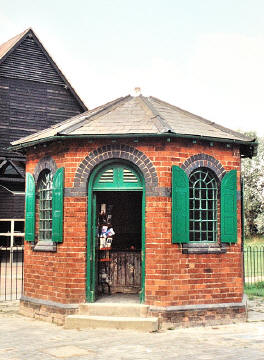

|
The Victorian Mission Church - from Bringsty
Common Herefordshire. Originally built in 1891. In its current position it is
consecrated and hosts services and wedding blessings throughout the year.
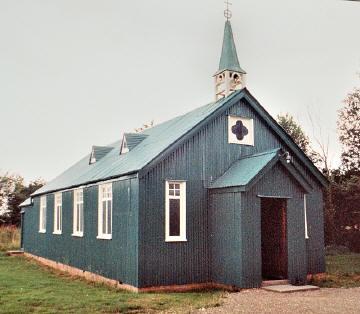
 |
| The Earth Closet (outdoor lav) from the 18th
Century and originally in the garden of Townsend House on the outskirts of
Leominster.
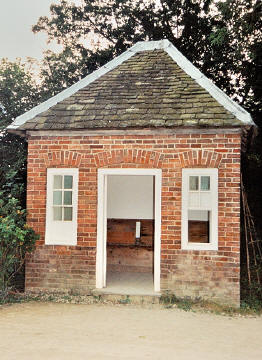
 |
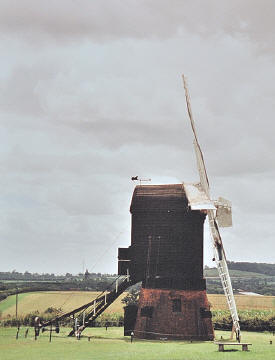

Danzey Green
Windmill, original 19th Century mill |
On the left is a pond and opposite is the 16th
century Cruck framed barn from Cholstrey Court Farm, near Leominster,
Herefordshire. There is also a Granary building nearby. From this area take the
path on the left and take a stroll down to see Danzey Green Windmill, the original 19th
Century mill, moved here in 1969. It is still a working windmill and on some
days you can go inside and take a look. Back up to the main area and the next
building is
The Perry Mill a two storey brick building
originally constructed between 1790 and 1810 from Redditch, used to make
Worcestershire Cider and Perry.
An 18th century wooden Wagon Shed from Hanbury
Worcestershire
The Chain Shop from Colley Gate, Cradley Heath.
A Nail Shop from Sidemoor in Bromsgrove - nail
making once employed 9000 people in the Bromsgrove area.
Next is the Wood Turners Workshop - where you
may see the resident wood turner displaying the skills of his craft.
The Tudor Merchants House built in 1558 by the
Lylley family, was the first building to be reconstructed here.
The 1940's prefab shows the type of
accommodation and living conditions of people in this area during World War II.
This example was originally built in 1946 at Moat Lane, Yardley, Birmingham.
| The Toll House, built in 1822 at Little
Malvern, would be home to the toll keeper. An ice house from around 1765 originally built
at Tong Castle in Shropshire. The castle was demolished in 1954 when the M54 was
built, but the Ice House was saved. From here go right and take a look at the
Dovecote from Haselour Hall in Staffordshire. The original structure was built
around 1600, although later was heightened and clad in brick. Now make your way
back down to see the 17th century Cock Pit and continuing on around the site.
Next is
The showmans wagon built for a travelling
fairground showman and is typical of the large 'living carriages' built in the
19th century.
A Cell Block from Ledbury in Herefordshire
which has 3 cells and each has its own ceramic flushing toilet.
Behind the cell block is the 18th century Forge
Cottage from Wellington in Herefordshire, originally it was a house and working
forge, now it houses the offices of the museum.

|
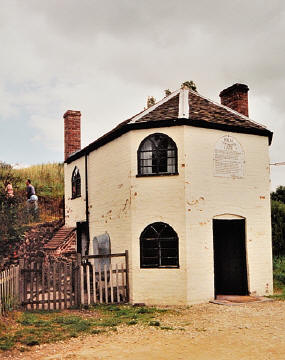 |
|
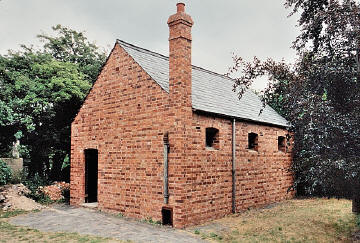
 Prison Cell Block
Prison Cell Block
 Prison Cell Toilet
Prison Cell Toilet |
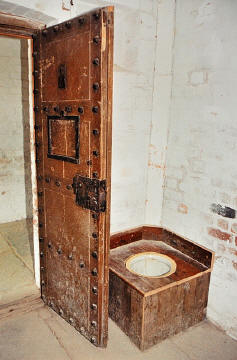 |
| Just one building left back towards the
entrance, and you will have seen this on your way in, is the Guesten Hall, a
modern building with a timber roof from the 1330's. Originally built as the
Guests Hall of Worcester Cathedral and now used for weddings and functions. On their website there is a virtual tour of the
site which allows you to see some of the positions of the buildings, which
generally are on grass areas, although the pathways around the site are
hardcore, even if a little uneven in places. Some of the buildings you enter may
have individuals in them in costume of the period who will answer questions and
tell you a little about what you can see. Also around there are information
boards giving the little of the history of the buildings.
It is probably worth allowing 3-4 hours for
your visit and is an interesting place from both finding out about the history
of the buildings and people who used them as well as being able to see and
photograph buildings of different time periods. Unlike some of the Open Air
Museums this is not on a very big site, so many times you can see a number
buildings in close proximity and for children or those with walking restrictions
it's ideal as there is not so much walking between exhibits.
|
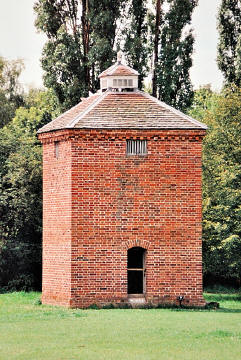 |
 The Dovecote
The Dovecote
.
Planning Grid
|
Location: |
Avoncroft, Bromsgrove, Worcestershire |
|
Grid Reference: |
SO952685 |
|
Getting there: |
located 2 miles south of Bromsgrove off the
A38 bypass, and is signposted from Junctions 4 and 5 of the M5, and Junction
1 of the M42. |
|
Access: |
|
|
Parking: |
Free car park |
|
Facilities: |
Tea room, Museum Shop, Picnic Area |
|
Things To Do,
See and Photograph: |
Buildings of different period throughout
history. |
|
What to take: |
|
|
Nature highlights: |
|
|
Address: |
Avoncroft Museum of Historic Buildings
Stoke Heath
Bromsgrove
Worcestershire |
|
Postcode: |
B60 4JR |
|
Telephone: |
01527 831363 or 01527 831886 |
|
Opening times: |
Apr-Jun and Sep-Oct 10.30am-5pm Tues-Sun
(closed Monday's unless a bank holiday).
July and August Daily 10.30am-5pm
Mar, Nov, Dec Fri-Sun only 1-.30am-4pm Closed
25-26th Dec. |
|
Charges: |
Adults £6.60; Child + Students £3 (under 5's
free); Seniors £5.50 |
|
Photo Restrictions: |
|
|
Other Restrictions: |
|
|
Special Needs Access: |
Access around Avoncroft site is generally
good, however owing to the nature and construction of some of the historic
buildings, access is restricted to some of them. |
|
Special Needs Facilities: |
Toilets and wheelchair loan |
|
Children Facilities: |
|
|
Dogs Allowed: |
|
|
CIN Page Ref: |
avoncroft |
Date Updated: 07/2008 |
|

|
Please let us know any other information that we
can add to the Further information and Planning Grids or page and any errors that you discover. Before making a long trip to any location it is always
wise to double check the current information, websites like magazines may be
correct at the time the information is written, but things change and it is of
course impossible to double check all entries on a regular basis. If you have
any good photographs that you feel would improve the illustration of this page
then please let us have copies. In referring to this page it is helpful if you
quote the CIN Page Ref at the bottom of the Planning Grid above. To print the
planning grid select it then right click and print the selected area.
Please submit information on locations you discover so
that this system continues to grow.
|